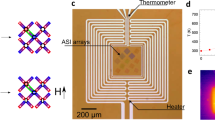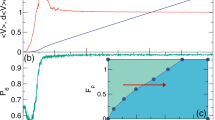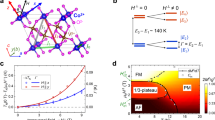Abstract
The problem of an ensemble of repulsive particles on a potential-energy landscape is common to many physical systems and has been studied in multiple artificial playgrounds. However, the latter usually involve fixed energy landscapes, thereby impeding in situ investigations of the particles’ collective response to controlled changes in the landscape geometry. Here, we experimentally realize a system in which the geometry of the potential-energy landscape can be switched using temperature as the control knob. This realization is based on a high-temperature superconductor in which we engineer a nanoscale spatial modulation of the superconducting condensate. Depending on the temperature, the flux quanta induced by an applied magnetic field see either a geometrically frustrated energy landscape that favours an ice-like flux ordering, or an unfrustrated landscape that yields a periodic flux distribution. This effect is reflected in a dramatic change in the superconductor's magneto-transport. The thermal switching of the energy landscape geometry opens new opportunities for the study of ordering and reorganization in repulsive particle manifolds.
This is a preview of subscription content, access via your institution
Access options
Subscribe to this journal
Receive 12 print issues and online access
$259.00 per year
only $21.58 per issue
Buy this article
- Purchase on Springer Link
- Instant access to full article PDF
Prices may be subject to local taxes which are calculated during checkout





Similar content being viewed by others
References
Daldini, O., Martinoli, P., Olsen, J. & Berner, G. Vortex-line pinning by thickness modulation of superconducting films. Phys. Rev. Lett. 32, 218–221 (1974).
Fiory, A. T., Hebard, A. F. & Somekh, S. Critical currents associated with the interaction of commensurate flux-line sublattices in a perforated Al film. Appl. Phys. Lett. 32, 73–75 (1978).
Pruymboom, A., Kes, P. H., van der Drift, E. & Radelaar, S. Flux-line shear through narrow constraints in superconducting films. Phys. Rev. Lett. 60, 1430–1434 (1988).
Otani, Y., Pannetier, B., Nozières, J. P. & Givord, D. Magnetostatic interactions between magnetic arrays and superconducting thin films. J. Magn. Magn. Mater. 126, 622–625 (1993).
Baert, M., Metlushko, V., Jonckheere, R., Moshchalkov, V. V. & Bruynseraede, Y. Composite flux-line lattices stabilized in superconducting films by a regular array of artificial defects. Phys. Rev. Lett. 74, 3269–3272 (1995).
Harada, K. et al. Direct observation of vortex dynamics in superconducting films with regular arrays of defects. Science 274, 1167–1170 (1996).
Metlushko, V. V et al. Supermatching vortex phases in superconducting thin films with antidot lattices. Europhys. Lett. 41, 333–338 (1998).
Metlushko, V. et al. Interstitial flux phases in a superconducting niobium film with a square lattice of artificial pinning centers. Phys. Rev. B 60, R12585–R12588 (1999).
Reichhardt, C. & Grønbech-Jensen, N. Critical currents and vortex states at fractional matching fields in superconductors with periodic pinning. Phys. Rev. B 63, 054510 (2001).
Field, S. B. et al. Vortex configurations, matching, and domain structure in large arrays of artificial pinning centers. Phys. Rev. Lett. 88, 067003 (2002).
Misko, V. R., Savel'ev, S. & Nori, F. Critical currents in superconductors with quasiperiodic pinning arrays: one-dimensional chains and two-dimensional Penrose lattices. Phys. Rev. B 74, 024522 (2006).
Villegas, J. E., Montero, M. I., Li, C-P. & Schuller, I. K. Correlation length of quasiperiodic vortex lattices. Phys. Rev. Lett. 97, 027002 (2006).
Sochnikov, I., Shaulov, A., Yeshurun, Y., Logvenov, G. & Bozović, I. Large oscillations of the magnetoresistance in nanopatterned high-temperature superconducting films. Nature Nanotech. 5, 516–519 (2010).
Reichhardt, C. & Olson Reichhardt, C. J. Moving vortex phases, dynamical symmetry breaking, and jamming for vortices in honeycomb pinning arrays. Phys. Rev. B 78, 224511 (2008).
Field, S., Witt, J., Nori, F. & Ling, X. Superconducting vortex avalanches. Phys. Rev. Lett. 74, 1206–1209 (1995).
Lee, C-S., Janko, B., Derenyi, I. & Barabasi, A-L. Reducing vortex density in superconductors using the ‘ratchet effect’. Nature 400, 337–340 (1999).
Villegas, J. E. et al. A superconducting reversible rectifier that controls the motion of magnetic flux quanta. Science 302, 1188–1191 (2003).
Jaksch, D., Bruder, C., Cirac, J. I., Gardiner, C. W. & Zoller, P. Cold bosonic atoms in optical lattices. Phys. Rev. Lett. 81, 3108–3111 (1998).
Korda, P. T., Spalding, G. C. & Grier, D. G. Evolution of a colloidal critical state in an optical pinning potential landscape. Phys. Rev. B 66, 024504 (2002).
Sampaio, J., Cros, V., Rohart, S., Thiaville, A. & Fert, A. Nucleation, stability and current-induced motion of isolated magnetic skyrmions in nanostructures. Nature Nanotech. 8, 839–844 (2013).
Dunkel, J. et al. Fluid dynamics of bacterial turbulence. Phys. Rev. Lett. 110, 228102 (2013).
Frauenfelder, H., Sligar, S. G. & Wolynes, P. G. The energy landscapes and motions of proteins. Science 254, 1598–1603 (1991).
Bonsall, L. & Maradudin, A. A. Some static and dynamical properties of a two-dimensional Wigner crystal. Phys. Rev. B 15, 1959–1973 (1977).
Crassous, A. et al. Nanoscale electrostatic manipulation of magnetic flux quanta in ferroelectric/superconductor BiFeO3/YBa2Cu3O7–δ heterostructures. Phys. Rev. Lett. 107, 247002 (2011).
Pauling, L. The structure and entropy of ice and of other crystals with some randomness of atomic arrangement. J. Am. Chem. Soc. 57, 2680–2684 (1935).
Harris, M. J., Bramwell, S. T., McMorrow, D. F., Zeiske, T. & Godfrey, K. W. Geometrical frustration in the ferromagnetic pyrochlore Ho2Ti2O7 . Phys. Rev. Lett. 79, 2554–2557 (1997).
Ramirez, A. P., Hayashi, A., Cava, R. J., Siddharthan, R. & Shastry, B. S. Zero-point entropy in ‘spin ice’. Nature 399, 333–335 (1999).
Bramwell, S. T. & Gingras, M. J. P. Spin ice state in frustrated magnetic pyrochlore materials. Science 294, 1495–1501 (2001).
Wang, R. F. et al. Artificial ‘spin ice’ in a geometrically frustrated lattice of nanoscale ferromagnetic islands. Nature 439, 303–306 (2006).
Möller, G. & Moessner, R. Artificial square ice and related dipolar nanoarrays. Phys. Rev. Lett. 96, 237202 (2006).
Libál, A., Reichhardt, C. & Olson Reichhardt, C. J. Realizing colloidal artificial ice on arrays of optical traps. Phys. Rev. Lett. 97, 228302 (2006).
Ladak, S., Read, D. E., Perkins, G. K., Cohen, L. F. & Branford, W. R. Direct observation of magnetic monopole defects in an artificial spin-ice system. Nature Phys. 6, 359–363 (2010).
Bhat, V. S. et al. Controlled magnetic reversal in permalloy films patterned into artificial quasicrystals. Phys. Rev. Lett. 111, 077201 (2013).
Qi, Y., Brintlinger, T. & Cumings, J. Direct observation of the ice rule in an artificial kagome spin ice. Phys. Rev. B 77, 094418 (2008).
Mengotti, E. et al. Real-space observation of emergent magnetic monopoles and associated Dirac strings in artificial kagome spin ice. Nature Phys. 7, 68–74 (2010).
Morgan, J. P., Stein, A., Langridge, S. & Marrows, C. H. Thermal ground-state ordering and elementary excitations in artificial magnetic square ice. Nature Phys. 7, 75–79 (2010).
Farhan, A. et al. Exploring hyper-cubic energy landscapes in thermally active finite artificial spin-ice systems. Nature Phys. 9, 375–382 (2013).
Marrows, C. Artificial spin ice: The heat is on. Nature Phys. 9, 324–325 (2013).
Farhan, A. et al. Direct observation of thermal relaxation in artificial spin ice. Phys. Rev. Lett. 111, 057204 (2013).
Zhang, S. et al. Crystallites of magnetic charges in artificial spin ice. Nature 500, 553–557 (2013).
Libál, A., Olson Reichhardt, C. J. & Reichhardt, C. Creating artificial ice states using vortices in nanostructured superconductors. Phys. Rev. Lett. 102, 237004 (2009).
Latimer, M. L., Berdiyorov, G. R., Xiao, Z. L., Peeters, F. M. & Kwok, W. K. Realization of artificial ice systems for magnetic vortices in a superconducting MoGe thin film with patterned nanostructures. Phys. Rev. Lett. 111, 067001 (2013).
Swiecicki, I. et al. Strong field-matching effects in superconducting YBa2Cu3O7−δ films with vortex energy landscapes engineered via masked ion irradiation. Phys. Rev. B 85, 224502 (2012).
Trastoy, J. et al. Unusual magneto-transport of YBa2Cu3O7− δ films due to the interplay of anisotropy, random disorder and nanoscale periodic pinning. New J. Phys. 15, 103022 (2013).
Blatter, G., Feigel'man, M. V., Geshkenbein, V. B., Larkin, A. I. & Vinokur, V. M. Vortices in high-temperature superconductors. Rev. Mod. Phys. 66, 1125 (1994).
Wördenweber, R., Kes, P. H. & Tsuei, C. C. Peak and history effects in two-dimensional collective flux pinning. Phys. Rev. B 33, 3172–3180 (1986).
Henderson, W., Andrei, E. Y., Higgins, M. J. & Bhattacharya, S. Metastability and glassy behavior of a driven flux-line lattice. Phys. Rev. Lett. 77, 2077–2080 (1996).
Tonomura, A. et al. Observation of individual vortices trapped along columnar defects in high-temperature superconductors. Nature 412, 620–622 (2001).
Auslaender, O. M. et al. Mechanics of individual isolated vortices in a cuprate superconductor. Nature Phys. 5, 35–39 (2008).
Lesueur, J., Nedellec, P., Bernas, H., Burger, J. P. & Dumoulin, L. Depairing-like variation of Tc in YBa2Cu3O7−δ . Phys. C Supercond. 167, 1–5 (1990).
Bergeal, N. et al. Using ion irradiation to make high-Tc Josephson junctions. J. Appl. Phys. 102, 083903 (2007).
Reichhardt, C., Groth, J., Olson, C., Field, S. & Nori, F. Spatiotemporal dynamics and plastic flow of vortices in superconductors with periodic arrays of pinning sites. Phys. Rev. B 54, 16108–16115 (1996).
Velez, M., Hoffmann, A., Schuller, I. K. & Vicent, J. L. Artificially induced reconfiguration of the vortex lattice by arrays of magnetic dots. Phys. Rev. Lett. 83, 1022–1025 (1999).
Acknowledgements
This work was supported by the French Agence Nationale de la Recherche (grant MASTHER, no. 2011-BS03-008-02), COST Action MP1201 “NanoSC” and the Ville de Paris Emergence Programme. J.T. acknowledges the support of Fundación Barrié (Galicia, Spain).
Author information
Authors and Affiliations
Contributions
J.E.V. conceived the experiments. R.B. and J.T. grew the YBCO films. C.U. performed electron-beam lithography. J.T. carried out the rest of the sample fabrication steps, and performed magneto-transport and vortex energy calculations. M.M. and N.B. realized the ion damage simulations. J.T. and J.E.V. analysed the results and wrote the paper. All authors contributed to the discussion of the results and revised the manuscript.
Corresponding author
Ethics declarations
Competing interests
The authors declare no competing financial interests.
Supplementary information
Supplementary information
Supplementary Information (PDF 1582 kb)
Rights and permissions
About this article
Cite this article
Trastoy, J., Malnou, M., Ulysse, C. et al. Freezing and thawing of artificial ice by thermal switching of geometric frustration in magnetic flux lattices. Nature Nanotech 9, 710–715 (2014). https://doi.org/10.1038/nnano.2014.158
Received:
Accepted:
Published:
Issue Date:
DOI: https://doi.org/10.1038/nnano.2014.158
This article is cited by
-
Switchable geometric frustration in an artificial-spin-ice–superconductor heterosystem
Nature Nanotechnology (2018)
-
Tunable and switchable magnetic dipole patterns in nanostructured superconductors
Nature Communications (2018)
-
Ice rule fragility via topological charge transfer in artificial colloidal ice
Nature Communications (2018)
-
Dynamic Control of Topological Defects in Artificial Colloidal Ice
Scientific Reports (2017)
-
Industrial-strength bonds
Nature (2015)



